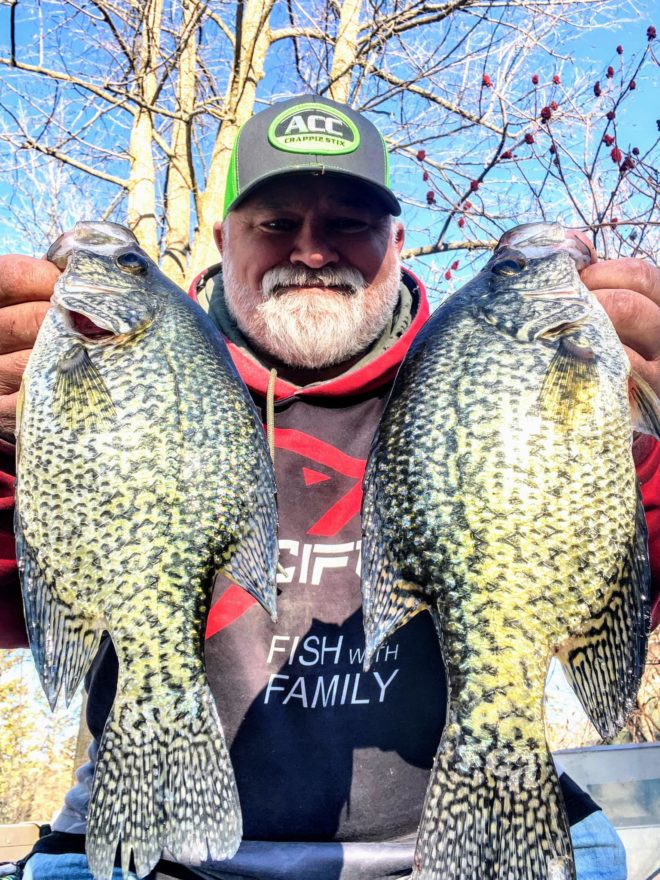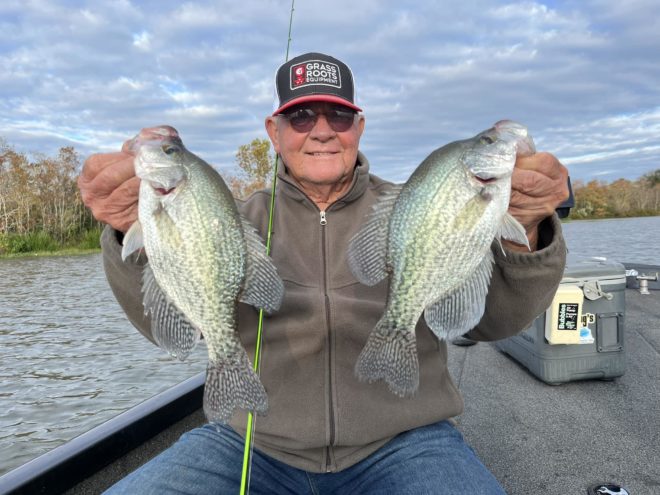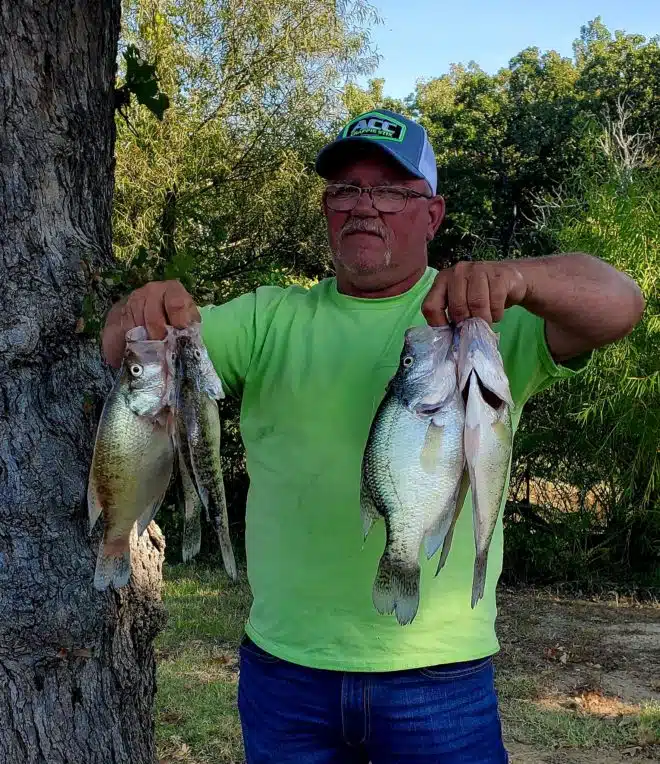5 things to know: Fishing river systems and dams

By Greg McCain
Crappie are most often associated with lazy water, still lakes and pools that require little energy for the fish to find their places of refuge.
Some crappie, however, are found in river systems or in current near dams. While some anglers acclimate their techniques and habits to target these fish, they are often a challenge for various reasons. They are present one day and gone the next although the fish may be close by and respond to similar presentations once found. On other days, they simply vanish.
Following are some ideas offered by members of the ACC pro staff, plus some personal observations about finding crappie in moving water:
1. Goose Gutzman (check out Goose’s Guide Service on FB for reports and trip info)
Goose has experience in finding crappie in many situations and different types of fisheries in the upper Midwest. Despite the availability of the many lakes near his Minnesota home north of Minneapolis, Goose makes some excellent observations about fishing rivers.
“I fished the Mississippi River for many years when I was younger and finding crappies can at times be challenging. The water level dictates everything in my opinion. High water is really tough because they can hide in trees and thick brush. But I find that normal water levels are the best, and low can be good as well. I find crappies in the backwater or in slack currents, ideally finding trees downed by beaver or storms because crappie like to hide in the limbs.
“I mainly vertical jig them. I cast a 1/32 oz AccCrappieStix jig watching my hi-vis line for subtle bites when I’m fishing holes in the backwaters. You can bobber fish them as well, but I personally prefer using my 6’6” ACC CrappieStix for any kind of jigging. So don’t be intimidated by a river and you will be surprised with how many species you can target besides crappies. You can spend a whole day on the river and hardly scratch the surface on good spots to try.”

2. Jonathan Phillips (Team Phillips Guide Service, 334.391.9735)
Jonathan finds plenty of crappie close to his Wetumpka, AL, home on the lower Coosa and Alabama rivers. The impoundments on the Alabama River are current-oriented and filled with crappie, including a good supply of two-lb. fish.
“The best I can tell you is that fishing a river system is challenging because rivers are seldom the same two days in a row. When the current is slack, crappie actually tend to be less predictable on the Alabama River. When the water is moving, the crappie tend to find current breaks, such as river bends, large solid structure, and around creek mouths. It gets way more complex than that at times because you have rising water conditions and dropping water conditions. I also agree with Goose on the importance of water levels as well. I have fished the river my whole life, and it will still leave me baffled sometimes.”

3. Don McClish (PointBreak Crappie Guide Service, 918.316.3363)
Don can typically be found guiding clients on Lake Eufaula (OK). A change of scenery is good for most fishermen, and Don has been known to sneak off to an Oklahoma river to chase slabs.
“It’s been quite a few years ago since I crappie fished below the dams, but (at) one dam in particular when the tree line was flooded, I’d grab a five-gallon bucket, load up a fanny pack full of jigs and corks and take off walking the bank, floating the jig and cork combo through the timber and absolutely ‘smoke’em.’ I can’t remember the magic release numbers at the moment, but too much current wasn’t good nor was too little current.
“On this same system, the boat ramp was about four or five hundred yards from the dam with a rip rap jetty blocking the current, which created a back flow. I’d wade out about waist deep and cast out the same jig and cork combo and just let it ride the swirl until I got bit.
“If the release amount was too much for the above techniques, we’d put in a flat-bottom boat equipped with a 15hp tiller and motor several miles downstream to where the first major creek dumped into the river and anchor out in the mouth of the creek and cast Roadrunners. These old school ways of fishing have probably produced some of the most fun and fastest action packed outings to date.”

4. Fishing Lake Guntersville … at night … in winter
Alabama’s Lake Guntersville is a famed largemouth bass fishery, but the crappie fishing is consistently better on a daily basis. That idea is a year-round, around-the-clock concept. A couple of the best crappie trips I’ve ever experienced anywhere were after midnight in January, the timing better suited to the many duck boats encountered on such occasions.
The winter crappie bite on Guntersville doesn’t slow. Only extreme current situations – 50,000 cfs may not be extreme for bass but it is for crappie – slows the cold-weather feeding binges. It actually doesn’t slow them; heavy current re-positions the fish.
One such occasion found the current ripping at about 70,000 cfs, but the guy I was fishing with knew the crappie were around. We tried one spot around a slight outcropping of a bank ledge with little success. Later, he allowed the boat to slide down the bank while re-tying. When we came to a slight cut in the vertical bank, only about a 10×3-foot indention protected from the current, his side imaging lit up in a solid blob. “Bait!” he said. A couple of casts later, all he could say was “Crappie! Hundreds of them!”
Crappie will find their comfort zone. In this case, that small space was all that was needed to hold hundreds of crappie.
5. Fish the eddies
Following up on Don’s comments above, eddy water holds crappie at times. I’ve witnessed the situation on the Tennessee River, especially in the Wheeler Dam tailrace. The area has several areas where the rocky bank protrudes into the current and creates an eddy. In other situations, a large tree or other obstruction can change the course of the current. Such areas are frequently inhabited by smallmouth. If smallmouth are not present, other game fish can be found in the gentle back current.
Crappie do not seem to like competition, so they will not likely be found if smallmouth, white bass/hybrids, or catfish move in. It’s always worth a few casts to check for the presence of crappie, and they will likely be found in at least some of the eddies formed along the bank or at creek mouths where slower current parallels the heavier moving water.
Rivers and dams may not be the first stop for many crappie fishermen. Crappie adapt to the current, however, and can definitely be found in river and tailrace areas. Identify the likely spots, and the potential to catch crappie is available, even in a slightly unorthodox way.













